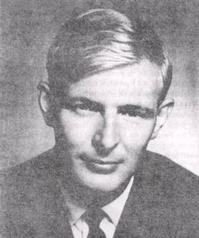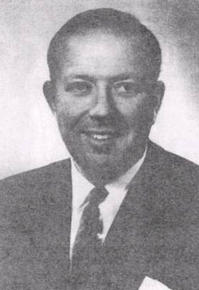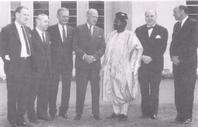


Memories of the Bureau, 1946 to 1962
Foreword
Terminology
Prologue
Preface
Chapter 1: The Warren Years, 1946 to 1950
Chapter 2: International Meteorology
Chapter 3: The Timcke Years, 1950 to 1955
Chapter 4: A Year at the Massachusetts Institute of Technology
Chapter 5: The Dwyer Years, 1955 to 1962
Chapter 6: A Springboard for the Future
My Springboard
Proposal for More Staff
Efforts to Improve Scientific Status of the Bureau
Gibbs-Priestley-White Prospectus
Successes and Struggles with Ministers and Permanent Heads
Submission to Royal Commission on Government Administration
The Committee of Inquiry
Achievements 1962 to 1978
Appendix 1: References
Appendix 2: Reports, Papers, Manuscripts
Appendix 3: Milestones
Appendix 4: Acknowledgements
Appendix 5: Summary by H. N. Warren of the Operation of the Meteorological Section of Allied Air Headquarters, Brisbane, 1942–45
Endnotes
Index
Search
Help
Contact us

My Springboard (continued)
Len took full advantage of his good fortune in having supportive Ministers and a helpful Permanent Head by showing great initiative in building the Bureau's public image and creating strong bonds with scientific and bureaucratic bodies such as CSIRO, the Australian Academy of Science, universities and the Public Service Board and Treasury. He also was a great communicator, both with the staff of the Bureau and with influential Australian and overseas authorities.The many discussions with our Ministers, Permanent Head, Public Service Board and Treasury in which Len and I were involved provided me with a working knowledge of the handling of the protocols and procedures of these discussions. My personal involvement in discussions with the CSIRO, the Academy of Science, and staffs of universities and other State and Commonwealth authorities during the Warren, Timcke and Dwyer years provided valuable links with those and other bodies. My experience with IMO and WMO activities, including that during the IGY and on the WMO Panel of Experts on Meteorological Satellites enabled me to establish channels of communication with many eminent overseas meteorologists.


I was fortunate to have the services of Harry Ashton, Allan Atkins, Allen Bath, Bill Brann, Walter Dwyer, Tom Hall, Frank Hannan, Keith Hannay, Keith Henderson, Ralph Holmes, John Lillywhite, George Mackey, 'Doc' Hogan (1912–1978), Jack Johnston, Neil McRae, Gerry O'Mahony, Barney Newman, Henry Phillpot, Bruce Retallack, Arch Shields and other experienced members of staff whose support was essential in running the Bureau. I was also fortunate to have a crop of younger staff members who provided a bridge for future development. Bob Southern was one who had shown initiative and dedication and was a natural selection in filling the newly-created position of Regional Director, Northern Territory.
Highlights of Bureau achievements from 1962 to 1978 were in the fields of instruments and observations, telecommunications, computers, NWP, forecasting, warning, climatological services, central analysis, training, publications, public relations, international meteorology and scientific research.
I took a special interest in planning the acquisition of an electronic computer. As described in Chapter 5 Len Dwyer had a keen interest in computers and had selected Gerry O'Mahony as the director of the project. Gerry had served on an interdepartmental committee on computing but it was not until 1963 that the administrative machinery for the creation and filling of positions was achieved and Gerry was formally promoted to the newly created position. I was particularly concerned that the computer acquisition, installation and commissioning should proceed smoothly because in Department of Defence John Ovenstone had encountered great difficulty in bringing a new computer into operation.

I insisted that our plan should be based on a consideration of all the possible Bureau activities in which a computer could be used and coined the term 'omnisystem' to describe this approach. I believe that this was somewhat irritating for Gerry O'Mahony but I was determined that our computer should become operational without delay once we had acquired it. Much of the full computer story is contained in the issues of Weather News from 1962 to 1968 when the computer was commissioned. It was one of the Bureau's many success stories.
In Chapter 5 I have referred to a note prepared by Ross Maine summarising some of the early Bureau achievements in NWP. While Gerry O'Mahony and I were heavily involved in procedures for preparing specifications for the type of computer required Ross and George Rutherford were working on the type of dynamical model which might be useful in the Bureau's Central Analysis Office (which later became a World Meteorological Centre of WMO's World Weather Watch).
Another project in which I took a special interest was the use of data from meteorological satellites in making synoptic analyses and prognoses of the Southern Ocean. My interest in photographs from the first meteorological satellite Tiros 1 was welcomed by the US Weather Bureau staff working on the satellite project. At that time many meteorologists were not excited by the prospect of data from satellites. It took many years to devise methods to bring satellite data into routine use in synoptic analysis. George Rutherford made an outstanding contribution in that field of work.
I had a special interest in increasing the awareness of the general public to the magic of the atmosphere and the advantages they could gain in using the services provided by the Bureau. I took every opportunity to encourage the news media to publicise the work of the Bureau. Frank Hannan (Senior Meteorologist, External Relations) and his successors developed contacts with journalists in the various media and the Bureau featured in many news reports. I also arranged for a conference involving a wide variety of users of Bureau products, proceedings of which were published by the Bureau with the title 'What is weather worth ?'. I wrote the text of a 17 page pamphlet Introducing the Bureau of Meteorology published in the mid 1960s which described Bureau activities and listed the Bureau as having a Central Office, seven Divisional Offices and 59 field offices.
I now turn to some of the important matters which were not fully reported in Weather News and which are only likely to be found in correspondence files which the Bureau has preserved. These include:
- my Cabinet submissions in the early 1960s which sought additional staff and recommended improvement of the Bureau's scientific status;
- the circumstances leading to the publication by Gibbs, Priestley and White of a prospectus for meteorological research;
- my submission to the Royal Commission into the Australian Government administrations, the report of which was left to gather dust in remote pigeonholes after the dismissal of the Whitlam Government;
- the struggle with a Permanent Head of the Department of Science who sought to diminish the authority of the Director of Meteorology; and
- the report of the Commission of Inquiry into the Bureau.
Organisations in Australian Science at Work - Central Analysis Office (CAO)
People in Bright Sparcs - Ashton, Henry Tamblyn (Harry); Bath, Allen Tristram; Brann, Harold Walter Allen Neale (Bill); Dwyer, Leonard Joseph; Hall, Thomas Taylor (Tom); Hannay, Alexander Keith (Keith); Henderson, William Keith; Hogan, John (Doc); Holmes, Ralph Aubrey Edward; Johnston, John (Jack); Lillywhite, John Wilson; Mackey, George William; Maine, Ross; McRae, John Neil; Newman, Bernard William (Bernie); O'Mahony, Gerard (Gerry); Priestley, Charles Henry Brian (Bill); Retallack, Bruce James; Shields, Archibald John; Timcke, Edward Waldemar; Warren, Herbert Norman; White, Frederick William George
 |
Bureau of Meteorology |  |
© Online Edition Australian Science and Technology Heritage Centre and Bureau of Meteorology 2001
Published by Australian Science and Technology Heritage Centre, using the Web Academic Resource Publisher
http://www.austehc.unimelb.edu.au/fam/1145.html